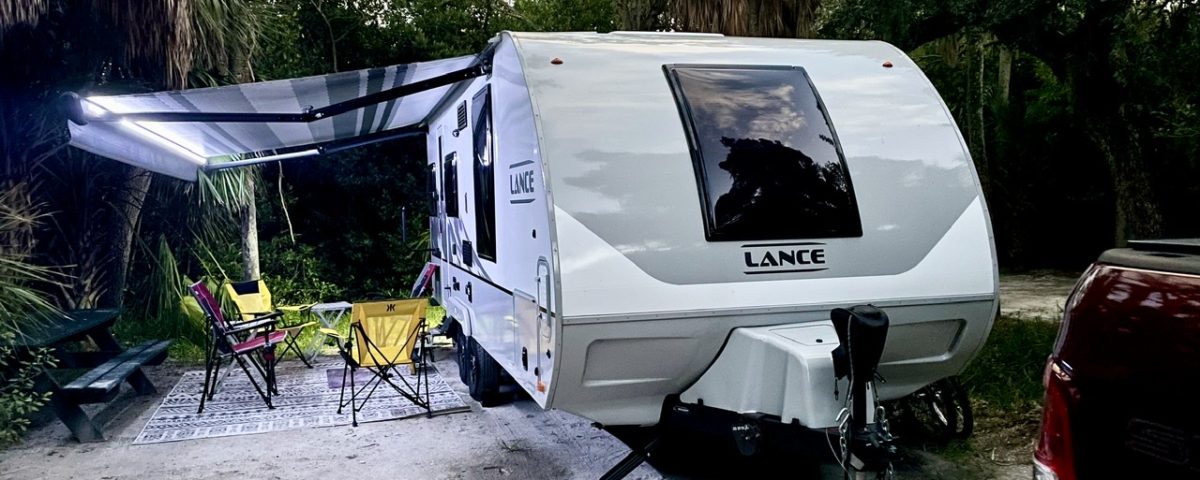First Year in our T@G
We purchased our teardrop, a T@G MAX XL, in September 2016. So, it has been a year now since we became teardroppers. Being new to camping in general and never previously having owned any type of camper. We learned a lot in this first year and have implemented T@G modification. Additionally, in the past year, our camper has been towed 3,430 miles on eight camping trips to five different states (AL, GA, FL, TN, & AR).
There were not any exceptionally long trips this first year for two reasons: 1) we had to figure out what we were doing and 2) we are actively working toward a knee replacement for my husband and it precludes long trips planned well in advance. Our longest trip lasted a week. We expect much longer trips next year.
Our T@G is really well-designed and is comfortable and functional, despite its size, but we did make a few minor changes.
1) Removal of the Headboard:
We had our dealer remove the headboard at the time of purchase. My husband is 6’3″ and he really needs the extra space. The headboard was nice, but comfort trumped utility in this instance. He is able to sleep very comfortably with this T@G modification.

2) DVD Light-Blocking Panel
My big guy cannot stand any light while sleeping and the light on the DVD player is quite bright. One of the first things he did was to make a panel to block the light. It attaches with Velcro and works very well. This T@G modification may appeal to those sensitive to light while trying to sleep.

3) Head Protection, Cabin and Galley
My husband’s height has caused some pain on a couple of occasions because the open shelving over the head of the bed had some hard edges. Bumping his head motivated him to look for a solution. He installed foam padding attached with glue strips. There have been no injuries since this was done.

He also shortened the length of the hex studs on the galley door. They were longer than necessary and he had scraped his head on them before the mod.

4) Greywater Drain Access
Having to crawl around on the ground to attach the hose to drain water from the sink was not one of my favorite things. A lady on one of the teardrop Facebook groups posted that she has a solution to provide easy access and I immediately requested the modification for our camper. Her solution was lower to the ground. We raised ours upon the recommendation of a plumber so it would be less likely to get caught on a curb or on uneven terrain.

5) License Plate Holder
The original way the holder was mounted was flimsy and hung low to the ground. One of the first things we did was to purchase a black plastic tag holder and mount it appropriately 1 1/2″ higher to the lower frame using the existing screws.
6) Naming the teardrop
We had no idea how camping would be for us and did not have a name for the trailer initially. After a little experience, we named it Endeavor and had the name installed on the back. There is an older post that describes the naming process and installation.
7) Inexpensive and easy air antenna
We purchased an air antenna at the time we got our camper and tried to use it several times. It did not do a great job, but we were often not in high reception areas. I saw a post on a Facebook teardrop group a where a gentleman was using a co-axel cable about 6″long to attach to the cable receptacle with the outer insulation stripped off by about 2.5″. It worked fairly well the one time we tried it and is more compact than the one we purchased. I am not sure how useful it will be as reception is not usually strong at campsites, but I like its simplicity.

8) Memory Foam Cover
As many campers have suggested, we installed a memory foam cover over the mattresses Ours is a 2″ cover and we also use a mattress pad for comfort and an added layer of separation from the memory foam itself for allergy reasons. It has made our bed quite comfortable. I don’t think the mattresses alone would have been adequate.
T@G Modification Reversal
We had a diffuser over the air conditioner because the constant blowing of air directly on us was annoying. It was a plastic traylike apparatus that was rather flimsy and stuck out quite a bit. However, we seemed to have more issues with condensation using it and it was an obstacle to be avoided. I managed to knock it down and break it the second trip it was used and we decided to not replace it.
Under Consideration
My tall husband has to stoop when under the galley. We checked with our dealer about the possibility of adding the Outback wheels to raise the overall height. This would get us electric brakes as well. It is a little pricey, but the bigger issue was a concern about the width and getting it into our garage. We still may do this at a later date.
Summary
In conclusion, our first year in Endeavor was wonderful and we have not make a lot of changes. We are happy with our T@G modification. Looking forward to year two!






















